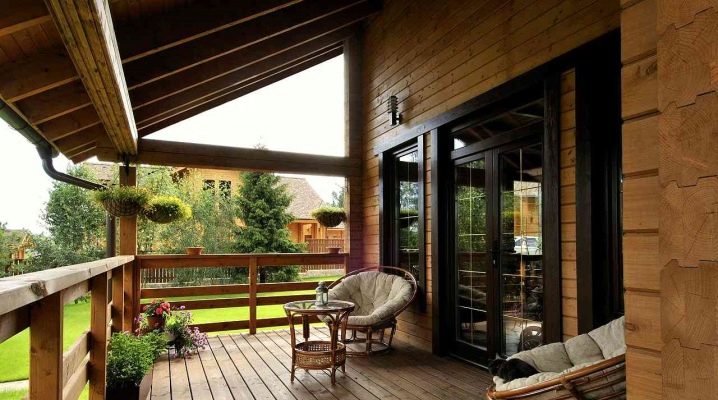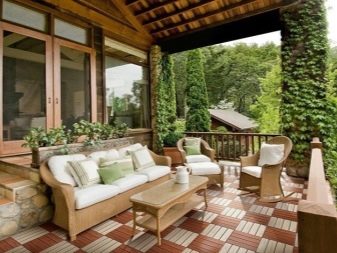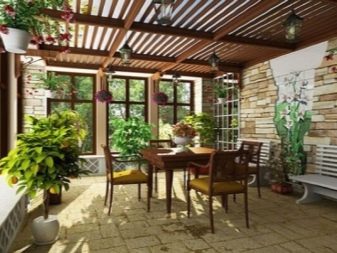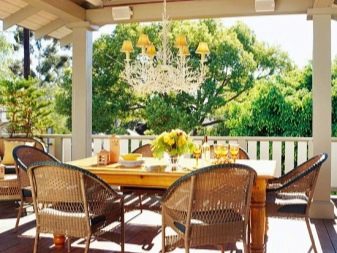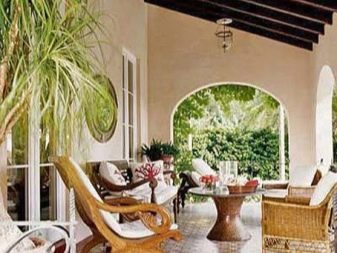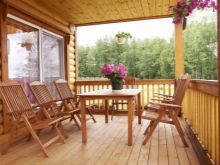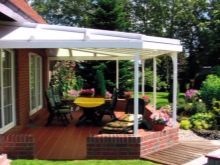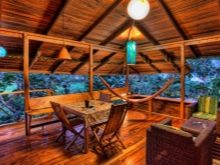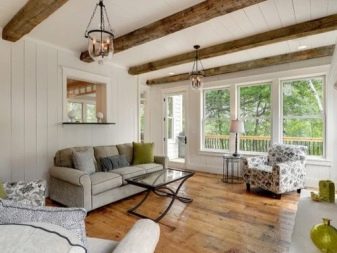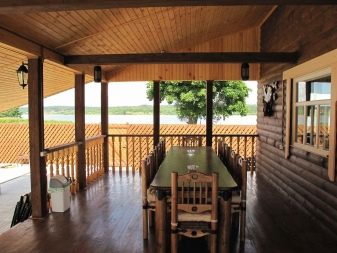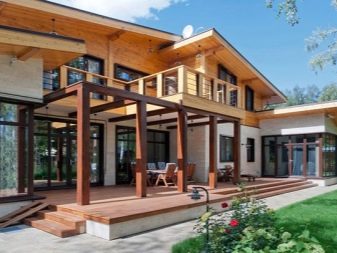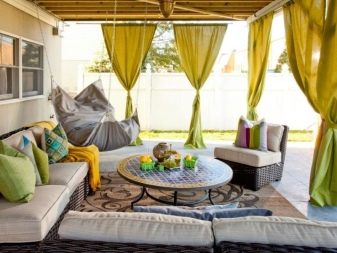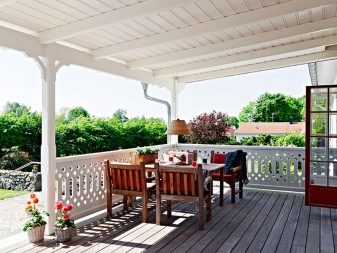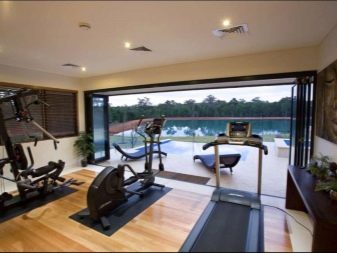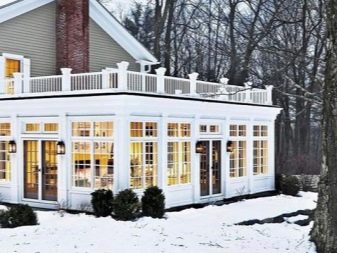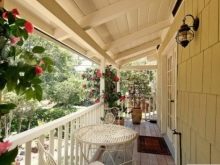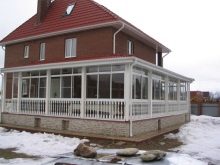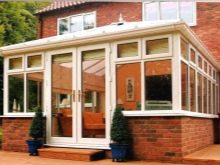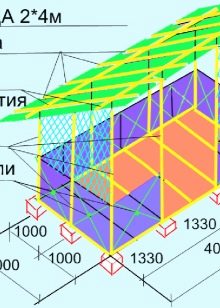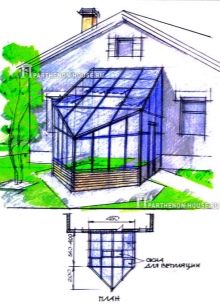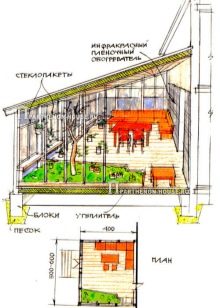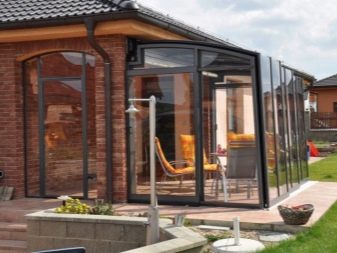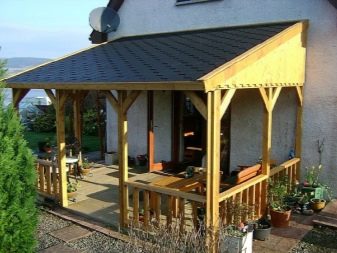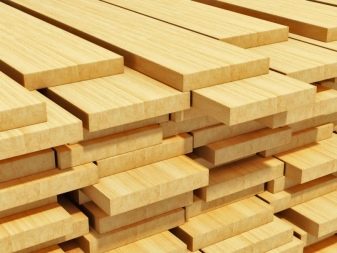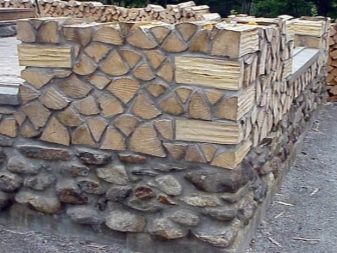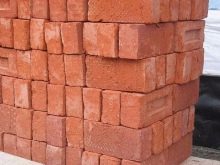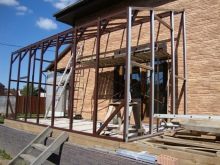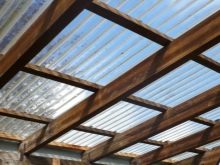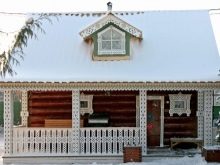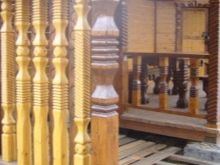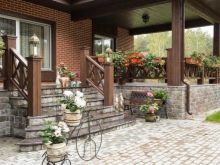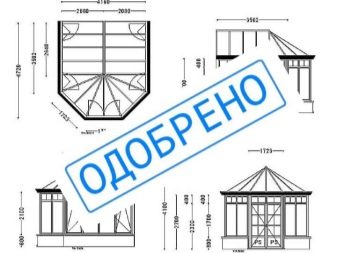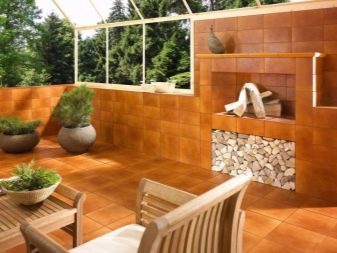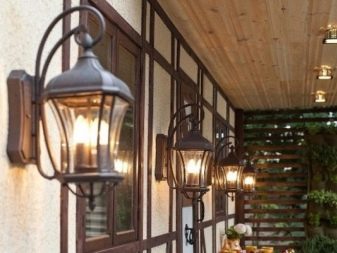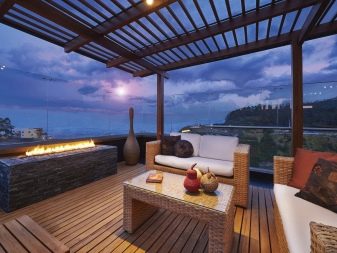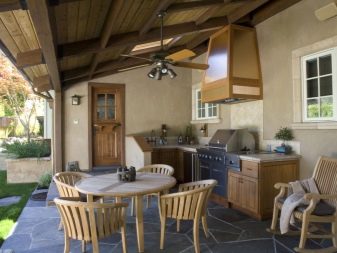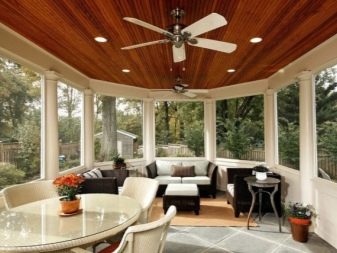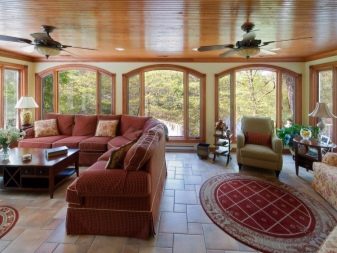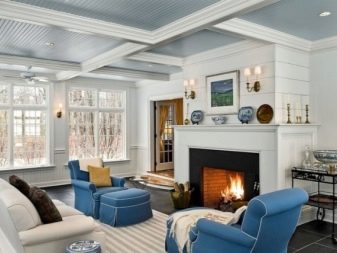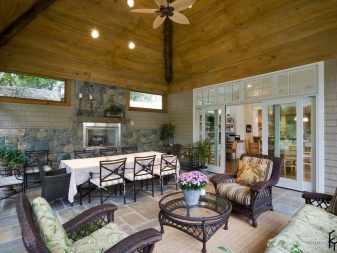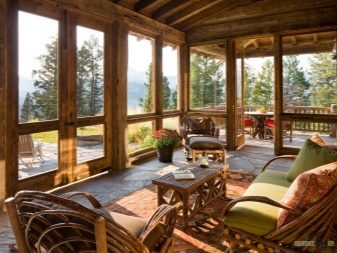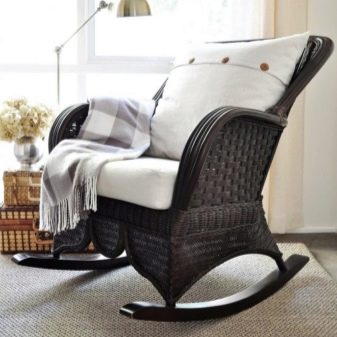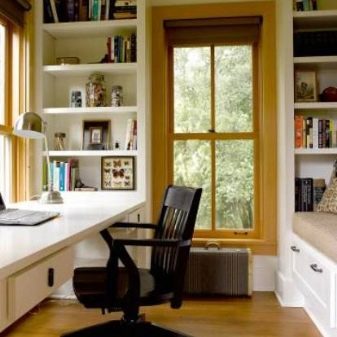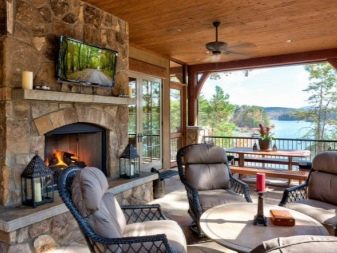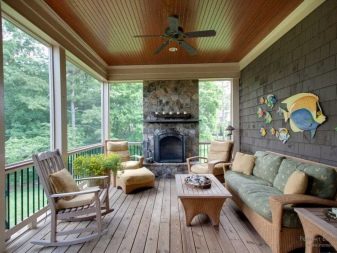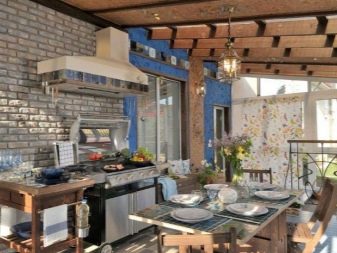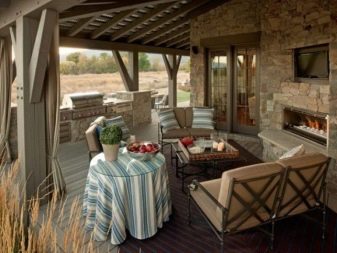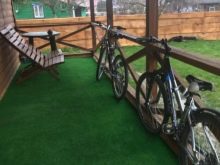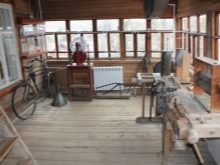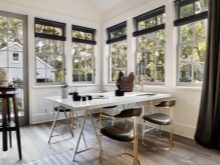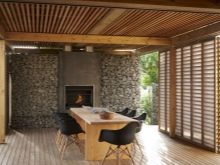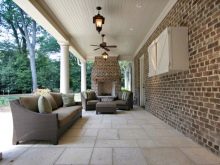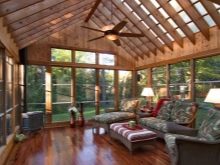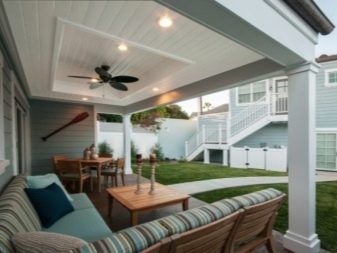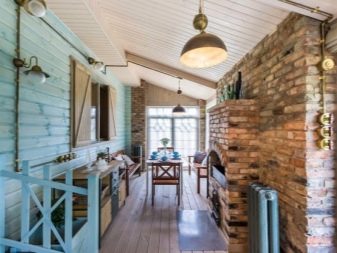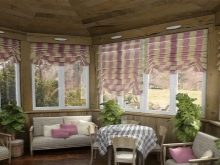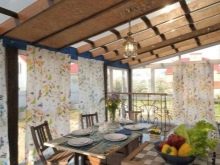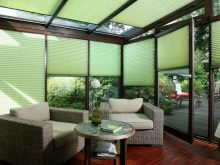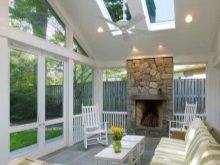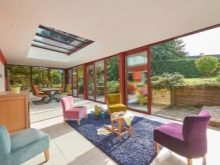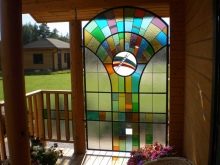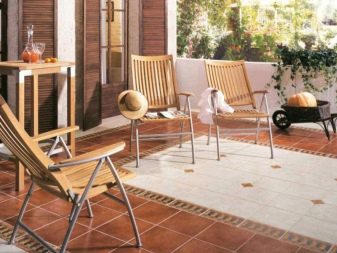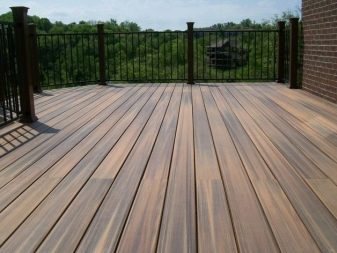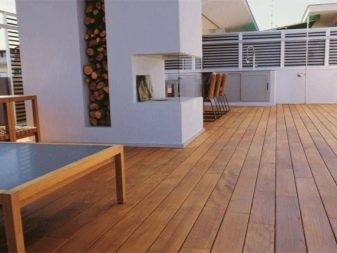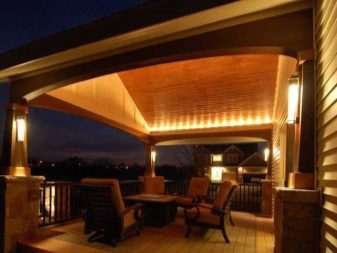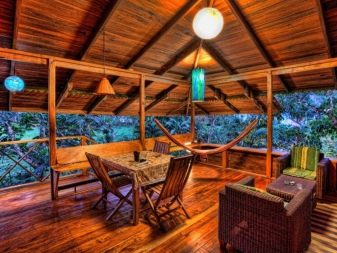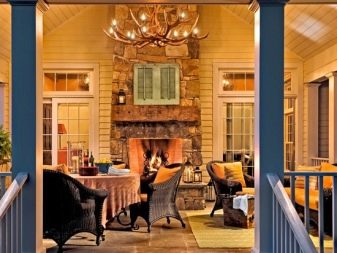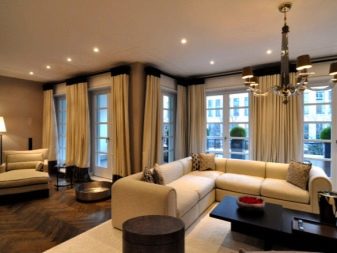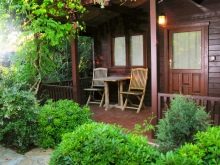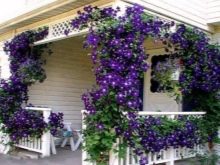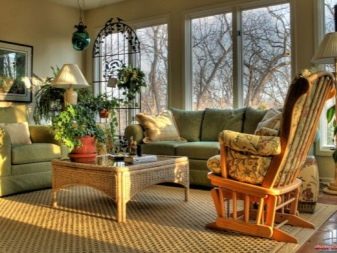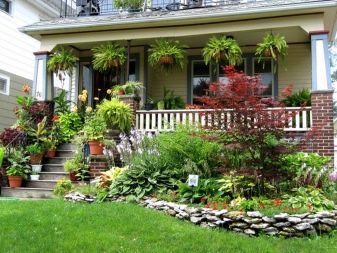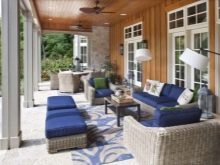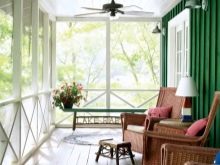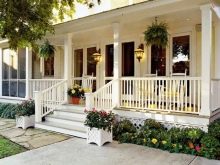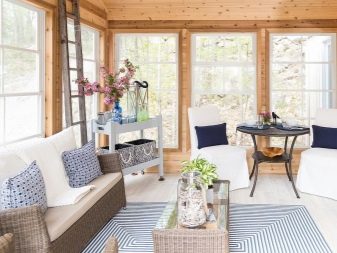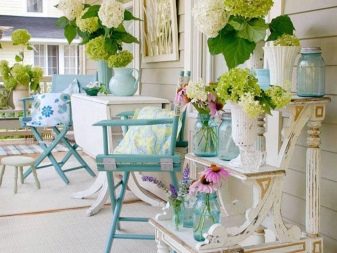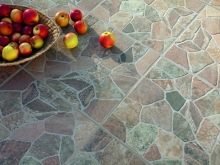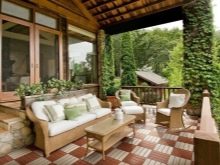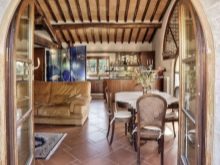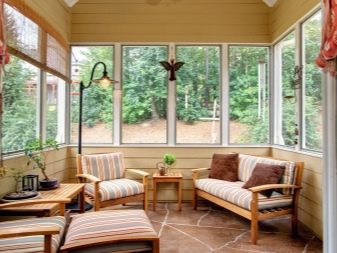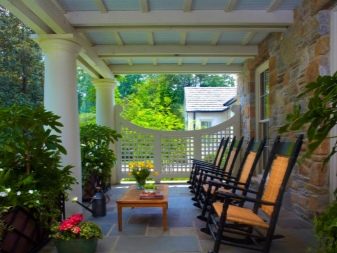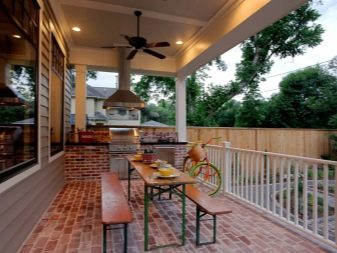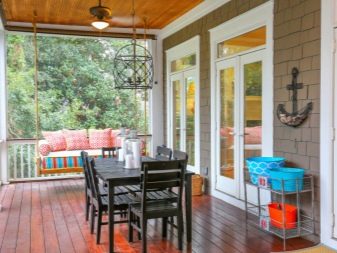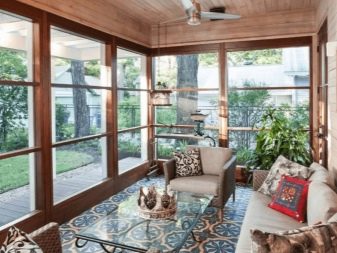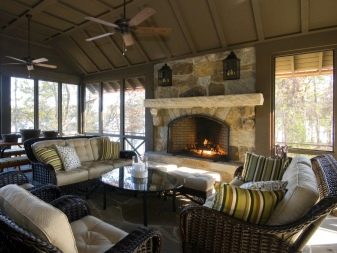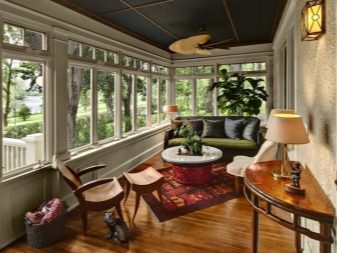Verandas at the cottage: options for arrangement and design
The veranda is a decoration of any private house or cottage. Thanks to her, there is the possibility of a pleasant pastime in the fresh air for a cup of tea or a peaceful conversation with family. To rest on the territory of this extension to the main house was as comfortable as possible, you must thoroughly approach its arrangement. Consider options for the design of the veranda, based on the types, choice of location, size and use of various materials with regard to their functionality.
Types and choice of location
In order not to confuse these extensions with terraces and gazebos, we note: the veranda is always distinguished by the presence of a foundation (which the terrace does not have) and a common wall with the main building (unlike the arbor).Among the masses of visible structures can be distinguished several types of buildings. They can be located on the same with the house or a separate foundation. In this case, the roof can be shared or own.
These extensions are usually located in the lower level of the house. They are classic recreation areas or so-called garden houses. An interesting solution is the presence of enclosing structures, which include pillars, a variety of racks, walls or panoramic windows.
Consider the most popular varieties of both types:
- Classic - one-story construction with maximum lighting, receiving zoning of space to highlight individual functional areas;
- An open annex is a budget type of a veranda, it is distinguished by the absence of walls, it can have partitions and railings, it adjoins the house with one wall (in fact, a framework without three walls);
- Two-level - full construction with glazed lower floor, with a garden house and an open area on top, with fences and connecting stairs;
- Surrounding - a variant that represents a kind of interroom communication, characterized by the possibility of entering the house from the street.
In addition to the main species, sometimes when doing a veranda, they create unique designs. For example, when the site space and budget allow, you can perform several extensions adjacent to the house. Most varieties are located on the front side of the house (cottage). If desired, they can be equipped for any functional room, including a recreation room, a dining room, a gym.
In most cases, verandas are attached to a wooden house. At the same time, it is important that the building does not harm the existing landscape design. Place try to choose in such a way that it is located close to the door of the house. This contributes to additional weatherization of the main dwelling, especially if the veranda is closed.
Summer variety can be attached to the side. It is much more difficult to carry out an option around the house. This will require harmonization with regulatory documents, which is often difficult. In this case, more often its closed part is located on the side of the entrance door.
In addition, they try to locate the veranda near the blank wall so that it does not obscure the natural light.
Experts strongly recommend building a veranda so that it closes the front door.
Dimensions
The parameters of any extension depend on your own preferences, the available budget and the number of people living in the house. If a family of 3-5 people lives in the house, an extension of 3x4 square meters is enough. m. If the site is small, but the veranda is a mandatory structure, then you can build a version of 2x4 square meters. m. Sometimes designs occupy 3.5x4.5 square meters. m. If the house is large, you can add a 4 x 6 square meter veranda. m
In each case, you should also focus on the functionality: the veranda should be comfortable; when planning, it is necessary to lay the distance for furnishing the room with furniture and freedom for movement. Otherwise, to create an atmosphere of comfort will not work, and to use the veranda in full, too.
Materials for construction and decoration
In the construction of verandahs use different raw materials. Professionals in the construction industry strongly recommend making these extensions from the same materials as the main building. However, for decorating the garden house you can use auxiliary raw materials, which today are presented in a wide range.So you can make the veranda more expressive, mark the contrast between the buildings.
More often for construction use:
- tree massif;
- a rock;
- brick;
- metal structures;
- plastic and plexiglass.
In most cases, the project involves the combination of materials for greater originality of buildings. For example, a marquise with a sloping roof can be a creative type of finish. Sometimes to give an unusual look using cloth. The foundation material is concrete. One of the modern methods of structure is the use of polycarbonate.
As a finish, use the materials that allows the budget. In most cases, try to use building materials that are resistant to moisture and adverse weather factors. Typically, the veranda is decorated with carved wooden elements (including slats, railings, wooden floor), stone in the form of steps, a roof with an unusual form of slopes. Inside it is decorated with a variety of eaves and plinths of synthetic materials.
Legitimation of the extension
Verandas increase the comfort of living and at the same time increase the usable area of the main dwelling.Depending on the type of structure and taste preferences of the owners of the house, they can be classic or original, unusual. Their main feature is the legalized factor in the relevant authorities. According to SP 54.13330, a veranda is classified as an unheated type room located on any floor. In the presence of glazing and heating, the classification is changed to a bedroom, nursery, living room or other residential type space.
Decoration inside
Registration of country verandahs and terraced designs differs. These extensions are more like full-fledged rooms, which allows you to design them in the best design traditions, choosing any style of interior as the basis. For example, a common wall can be laid out with cold-resistant clinker tiles: this will create a visual accent and allow you to isolate the veranda from the main building.
An interesting solution would be to use to accent wall with lantern doors in an old design. If you have creative skills, decorate the veranda in the same style as the main building will be easy. Consider the key moments of the arrangement of the veranda in the country.
Furniture
A unique opportunity to decorate the veranda is to use in the setting of upholstered or cabinet furniture. The choice of set may be different. If the veranda is open, try to use mobile objects, which in the case of rain can be brought into the house or wooden, plastic furniture, which is not terrible weather.
If the veranda has glazing, any kind of upholstered furniture (from modular to rattan) is allowed.
If the purpose of the veranda is to receive guests, it is arranged under the living room, complementing the set of furniture with a coffee table. It can be made of wood or reinforced colored glass. To a set of upholstered furniture can add couches and padded stools. In each case, the furniture ensemble is subject to room footage.
If the space is determined by a recreation area, it has a sofa. When you want hospitality, the veranda is set aside under a combined living room with a dining area, adding a dining table and chairs to the decor.
If the veranda is a peculiar office, it is equipped with a desk, a comfortable chair, complementing for convenience during moments of rest a compact sofa, rocking chair, woven mat and soft blanket.In this case, it is important not to overload the situation with an abundance of accessories, so that the atmosphere remains working, but not without comfort. For illumination, you can use small side tables, sliding them to a blank wall or glass windows without too much decoration.
Accessories
One of the ornaments of the veranda is a fireplace. Today, manufacturers offer such products in a wide range. Even bio- and falshkamine will be able to bring a home-like atmosphere into the veranda space. To make the atmosphere more relaxing, they add lamp-fans, as well as cushions of various shapes and textures. Of course, any furniture will look elegant and complete if it is decorated with stylish capes or blankets.
If the space is reserved for the kitchen-dining room, a set of accessories is expressed by shelves for dishes, bulk products. In addition, the space is usually supplemented with an exhaust hood, interesting fixtures, figurines, barrels, sometimes laconic paintings on the kitchen theme (fruits, food).
If a closed room is a place for children to relax, it is supplemented with toys and a carpet. Balls, bicycles and other items can be stored in an open space. If the room is set aside under a creative workshop, you can additionally equip it with overhead organizing tables, suspended from the armrests of the chairs or the sofa. Sometimes the cuckoo clocks and decorative panels become a stylish accessory for the porch.
Ceiling and walls
In this case, it is important that the wall and floor do not merge. You can use the same material for finishing, for example, painting the ceiling or walls. If the building is closed, you can apply frost-resistant lining or cladding (for example, under a torn stone or brickwork, wall panels). In order not to overload the design of the veranda, you can decorate it with panoramic windows. The use of timber of the same type and color on the walls and ceiling will create a negative perception, so the tree loses its expressiveness.
To the interior looked beautiful, it is necessary to separate the two planes. For example, if a tree is taken as the basis for the construction, you can paint the ceiling, fences and pillars with white paint, for a common wall, choose a rich tone coating.In the case of principled emphasis on wood on the ceiling and walls, it is necessary to separate them by means of light and dark wood tones.
The wall with the entrance door is better to arrange another material. Shades can be related, but the main thing is to exclude color identity.
Decoration of the ceiling are lamps, as well as beams.
Window
Veranda windows play a crucial role in its lighting. Their design is subject to the overall design idea. If the classic solution is chosen as the basis, you can see curtains on the windows, which are sometimes tied up to the support columns, sometimes they are collected in coat tails. At the same time, textiles try to choose light, sometimes translucent, so that when decorating the veranda, they do not hide the lighting of the space.
As an alternative decor, you can use roller blinds or wicker options from thin straws. Sometimes the decoration is carved and curly lines around the perimeter of the window openings.
If the style does not require the presence of curtains, window openings are framed with a material of a noble shade. You can separate them from the walls with the help of color. For example, on walls of sand or wood color, windows in white frames look good.If one of the walls is decorated with a decorative stone of beige and gray tones, you can decorate the window openings with frames in a rich brown shade.
It looks beautiful and unusual solution with panoramic windows, as well as the use of simple stained glass compositions. Today, you can make such a decoration with your own hands, using ordinary PVC film.
Floor
The floor covering of the veranda must be reliable, durable and durable. It saves the house from the main dirt and dust, delaying them on the threshold. In addition, it is important that it withstand temperature differences and daily weight loads. This option can be porcelain.
The size of the lining is better to choose the average (for example, 600x600x20 mm), so as not to visually split up the space due to the abundance of small dies.
The important point is the type of flooring: it must be different anti-skid to eliminate the risk of possible injury. The color of the coating is selected on the basis of practical considerations. An interesting solution is the plank floor. However, wood is subject to destruction under the influence of adverse external factors. If you use such material for the floor of an open veranda, then over time he will need to be dismantled.
Lighting
To create a homely atmosphere, it is necessary to fill the lack of natural lighting, which is usually inherent in buildings of this type. If the building is open, then for illumination use lamps in the closed canopies. One of the interesting solutions is the use of waterproof LED backlighting. Due to the silicone film, it can be used under water, so this lighting will not be afraid of rain and damp.
There are no problems with closed rooms. Pendant lights are most often used here. In this case, lighting devices may have ceiling lamps. Sometimes these are chandeliers with candle-shaped shades, as well as spotlights of the built-in type. The choice of lighting devices depends on the style of the interior.
Gardening
This technique allows you to bring a share of comfort to the veranda; any interior with flowers or plants in pots looks complete and harmonious. Plants can be very different: this is the usual indoor varieties installed on the window sills, and hanging compositions with flowers. The decoration of the climbing green looks beautifully, which can be located, for example, on the wall connecting the main building with the veranda.An interesting stylistic device is the use of supports, which visually seems to be absent altogether, although they are completely covered with greenery.
Sometimes gardening techniques make a full-fledged summer garden out of the veranda. Its characteristic feature is the use of different plants for open and closed verandas. For example, extensions that are more close to living quarters are usually decorated with flowers in vases, pots, hanging them in pots, or performing special hanging compositions. For open (summer) designs relevant hanging and braiding plants without flowers.
Subtle color
The stereotype that woody tones should dominate the interior of the veranda has lost its relevance today. Of course, they look beautiful, but if the color of the walls and the floor of the ceiling is identical, any interior will become boring. Undoubtedly, it is difficult to use light colors of the palette and especially white color. However, you can combine the finishing of different colors to show the uniqueness of the room, and at the same time fill it with bright spots, which is usually not enough for the veranda.
Try to avoid dark tones. However, if this finish is already there, you need to soften it with light accents. For example, a white or light milky, beige ceiling will allow to bring a positive into the space, although in a closed room it will be more appropriate. If you chose sandy tone as the basis for an open room, dilute it with green with live plants, hang light curtains on windows with white frames.
The floor can be made gray or coffee. If the store has a porcelain stoneware with a stone texture, made with transitions of tones, it makes sense to decorate the floor surface with it. If you want to choose a tile, use the technique of combining color: in places of greater permeability, put a dark material with a pattern.
Design options
To have a visual idea of how best to equip the veranda in the country or in a country house, you can refer to examples of photo galleries.
The original reception of the design of the veranda with glazing. The design feels light and airy. The minimum set of furniture helps to create a relaxing atmosphere. The combination of woven and rolled curtains looks very harmonious.
Reception gardening porch makes it special, fresh in summer.
The green color goes well with the masonry wall finish.
Veranda-dining room looks unusual and stylish. The use of a concise table and benches along with a stove and a brick-lined cooking zone brings a special touch to the interior of the open-air veranda. Dot illumination will allow to settle down in the open air at any time.
A simple example of using the minimum set of furniture in the form of a table and chairs on a narrow veranda will allow the whole family to sit at dinner during the summer. Completing the arrangement of the veranda is a swing with a soft seat and cushions.
If the interior is a lot of wood tones, you can dilute them with tiles in finishing the flooring. Stretch the atmosphere of the abundance of large windows. To get rid of negative perception, you need to add living greens and at least one bright accent to the design, for example, a beautiful decorative pillow of an interesting texture.
In a closed space, you can create a respectable interior. For example, if the roof of a veranda has a complex form of a slope, you can decorate it with beams, add a fireplace to the decor and place a set of furniture near it,decorating it with a mass of cushions.
An example of arranging the veranda under the personal space for reading books and thinking. Created the maximum conditions for a comfortable pastime. A sofa will allow you to relax, a chair - read a book, table lamps will provide an adequate level of light.
The way of playing around the dark ceiling through the furniture of an elegant and beautiful shade. Through the use of furniture, curtains and accessories in related shades of muted green, the sense of gravity is smoothed out, and the illusion of the versatility of the interior is created.
For information on how to alter and improve the veranda in the country, see the following video.
